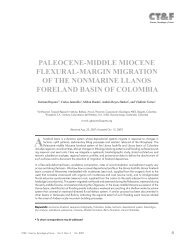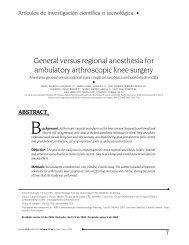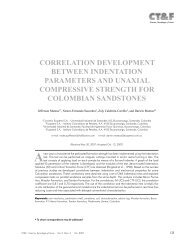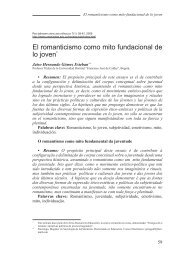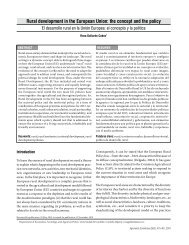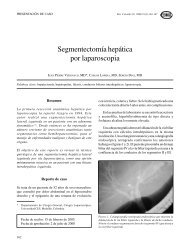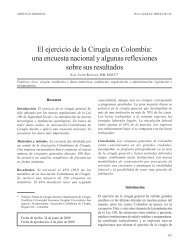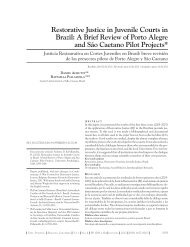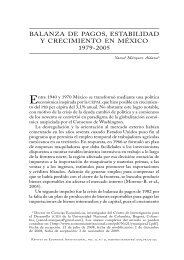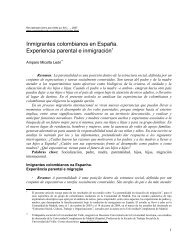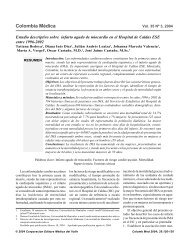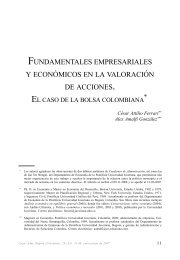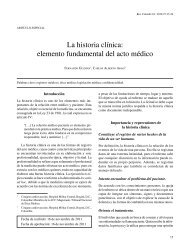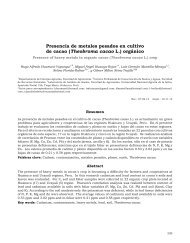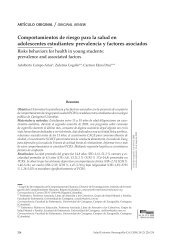Behavior and strength of welded stud shear connectors in composite ...
Behavior and strength of welded stud shear connectors in composite ...
Behavior and strength of welded stud shear connectors in composite ...
Create successful ePaper yourself
Turn your PDF publications into a flip-book with our unique Google optimized e-Paper software.
Rev. Fac. Ing. Univ. Antioquia N.° 63. Junio 2012<br />
Conclusions<br />
Accurate nonl<strong>in</strong>ear f<strong>in</strong>ite element models have<br />
been developed to <strong>in</strong>vestigate the behaviour <strong>of</strong><br />
<strong>shear</strong> connection <strong>in</strong> solid slab <strong>composite</strong> beams.<br />
The models take <strong>in</strong>to account the nonl<strong>in</strong>ear<br />
material properties <strong>of</strong> concrete, steel beams<br />
<strong>and</strong> headed <strong>stud</strong> <strong>shear</strong> <strong>connectors</strong>. The <strong>shear</strong><br />
connection capacity <strong>and</strong> the load-slip behaviour<br />
<strong>of</strong> headed <strong>stud</strong> were predicted from the f<strong>in</strong>ite<br />
element analysis, <strong>and</strong> the results were compared<br />
with experimental results. The parametric <strong>stud</strong>y<br />
showed that the expression given <strong>in</strong> EC-4 [4]<br />
produced better results when compared with FE<br />
results, while it would appear that the AISC [3]<br />
might have overestimated the <strong>shear</strong> connection<br />
capacity. Furthermore, all the codes seem to<br />
overestimate the <strong>shear</strong> capacity <strong>of</strong> the 22.22 <strong>and</strong><br />
25.4 mm diameter headed <strong>stud</strong>s.<br />
A modification <strong>of</strong> the expression given <strong>in</strong> EC-4<br />
is proposed <strong>in</strong> this work. The constant 0.37 <strong>of</strong><br />
the equation was changed to 0.32 for 22.22 <strong>and</strong><br />
25.4 mm diameter headed <strong>stud</strong>s. A new reduction<br />
factor (γ) was <strong>in</strong>troduced <strong>in</strong> order to consider the<br />
effect <strong>of</strong> the proximity <strong>of</strong> the <strong>stud</strong> <strong>connectors</strong>,<br />
<strong>and</strong> the reduction factor proposed by the EC-4 to<br />
consider the h c<br />
/d ratio was also modified.<br />
The comparison <strong>of</strong> the <strong>shear</strong> connection capacity<br />
obta<strong>in</strong>ed from the f<strong>in</strong>ite element analysis, the<br />
new expression <strong>and</strong> the design rules specified<br />
by the American Specification <strong>and</strong> the European<br />
Code have shown that the new expression (Eq.<br />
6) produced better results with a good correlation<br />
with the f<strong>in</strong>ite element analysis.<br />
References<br />
1. D. Lam, E. Ellobody. “<strong>Behavior</strong> <strong>of</strong> Headed Stud<br />
Shear Connectors <strong>in</strong> Composite Beam”. Journal <strong>of</strong><br />
Structural Eng<strong>in</strong>eer<strong>in</strong>g, ASCE. Vol. 131. 1. 2005. pp.<br />
96-107.<br />
2. E. Ellobody, B. Young. “Performance <strong>of</strong> <strong>shear</strong><br />
connection <strong>in</strong> <strong>composite</strong> beams with pr<strong>of</strong>iled steel<br />
sheet<strong>in</strong>g”. Journal <strong>of</strong> Constructional Steel Research.<br />
Vol. 62. 2006. pp. 682-694.<br />
3. AISC. Load <strong>and</strong> resistance factor design specification<br />
for structural steel build<strong>in</strong>g. American Institute <strong>of</strong><br />
Steel Construction. Chicago (USA). 2005. pp. 20-80.<br />
4. Eurocode 4 (EN 1994-1-1). Des<strong>in</strong>g <strong>of</strong> Composite Steel<br />
<strong>and</strong> Concrete Structures. European Committee for<br />
St<strong>and</strong>ardization. Part 1.1(2004). Brussels, Belgium.<br />
2004. pp. 14-89.<br />
5. J. Bonilla. E<strong>stud</strong>io del comportamiento de<br />
conectadores tipo perno de estructuras compuestas<br />
de hormigón y acero mediante modelación numérica.<br />
Tesis de Doctorado. Universidad Central de Las Villas.<br />
Sta Clara, Cuba. 2008. pp. 46-125.<br />
6. J. Lubl<strong>in</strong>er, J. Oliver, S. Oller, E. Oñate. “A Plastic-<br />
Damage Model for Concrete”. International Journal<br />
<strong>of</strong> Solids <strong>and</strong> Structures. Vol. 25. 1989. pp. 229-326.<br />
7. J. Nie, C. Cai. “Steel-Make specific Composite Beams<br />
Consider<strong>in</strong>g Shear Slip Effects”. Journal <strong>of</strong> Structural<br />
Eng<strong>in</strong>eer<strong>in</strong>g. Vol. 129. 2004. pp. 495-506.<br />
8. J. Ollgaard, R. Slutter, J. Fisher. “Shear Strength <strong>of</strong><br />
Stud Connectors <strong>in</strong> Lightweight <strong>and</strong> Normal-Weight<br />
Concrete”. Eng<strong>in</strong>eer<strong>in</strong>g Journal, AISC. Vol. 8. 1971.<br />
pp. 55-64.<br />
9. J. Bonilla, R. Larrúa, C. Recarey, E. Mirambell.<br />
“Corrección del cálculo de la capacidad resistente<br />
última de conectadores tipo perno de estructuras<br />
mixtas en la tipología de viga-losa maciza”. Revista<br />
Ingeniería Civil, CEDEX. No. 155. 2009. pp. 127-142.<br />
10. M. Rambo. <strong>Behavior</strong> <strong>and</strong> Strength <strong>of</strong> Welded Stud<br />
Shear Connectors. Ph. D. Thesis. University <strong>of</strong><br />
Blacksburg. Virg<strong>in</strong>ia, EE.UU. 2002. pp. 75-120.<br />
104



